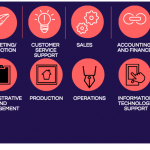In the past 18 months in particular, the value of eCommerce sales has boomed. With consumers confined to the comfort of their own homes, some of retails biggest giants saw huge spikes in sales.
Unlike B2C, the B2B market has been a lot slower on the uptake of eCommerce. But it’s on the rise with 25% of businesses looking at suppliers online before they purchase.
As the B2B world begins to adopt eCommerce due to the fierce demand from customers, you may be left wondering what the key differences are between B2B and B2C eCommerce. To summarise, we’ve put together our top 5 key differences between B2B and B2C eCommerce and how it could work for your business.

- Product pages
One of the key differences between a product page for B2B is that they are typically in much greater technical detail to aid the business in their decision-making process.
Thinking about this logically, it makes sense.
For a B2B audience, you are speaking as experts, to experts, so the detail on your product pages will differ to that of a B2C audience. For B2B, you’ll want to focus on things such as buying guides, product videos and support, articles and case studies.
In the same breath, a B2C site will rely more on customer reviews, creative imagery and main product highlights to appeal to a consumer.
- Website search functionality
B2C websites often have a simpler range of products compared to B2B. As B2B sites tend to have more variations and models available, the site needs to have advanced search capabilities with in-depth filter options to find specific products.
- Sales volume and order value
Another key difference is the order value. B2B eCommerce sites often deal with larger sales volumes and higher average order values, whereas B2C tend to buy in small volumes with reduced order values.
For example, it’s not uncommon for businesses to spend thousands buying items in bulk, whereas this would be highly unusual for a B2C site!
- Sales and account management is common for B2B sites
If you’ve ever bought an item online as a consumer, chances are you didn’t get access to an account manager. This is one of the key differences between B2B and B2C sites.
As B2B eCommerce sites have a higher order value and customers often buy in bulk, this can cause issues with shipping. As such, you may be allocated a dedicated sales or account manager to help work through the logistics of the order as part of a B2B purchase.
Along with the need for more personalised and comprehensive customer support, B2B sites require more in-depth account creation too.
On the other hand, B2C sales transactions are usually straight forward and can largely be automated, without the need for an account manager.
- Branding and web design
You may be interested to know that even branding is different for B2B audiences. A B2B eCommerce site is likely to be more professional and informative than a B2C store which is usually more creative and informal. As you are targeting other businesses with a B2B site, the web design needs to align to customer expectations and requirements. No controversial branding here!
In conclusion
Developing an optimised B2B eCommerce offering can be tricky so it’s best to seek out support from specialist eCommerce agencies to guide you through platforms like Adobe Commerce. With so many different aspects to think about, it can be hard to know where to start.
However, by tackling your branding, functionality and product pages first, you can be well on your way to running a successful B2B eCommerce site.










